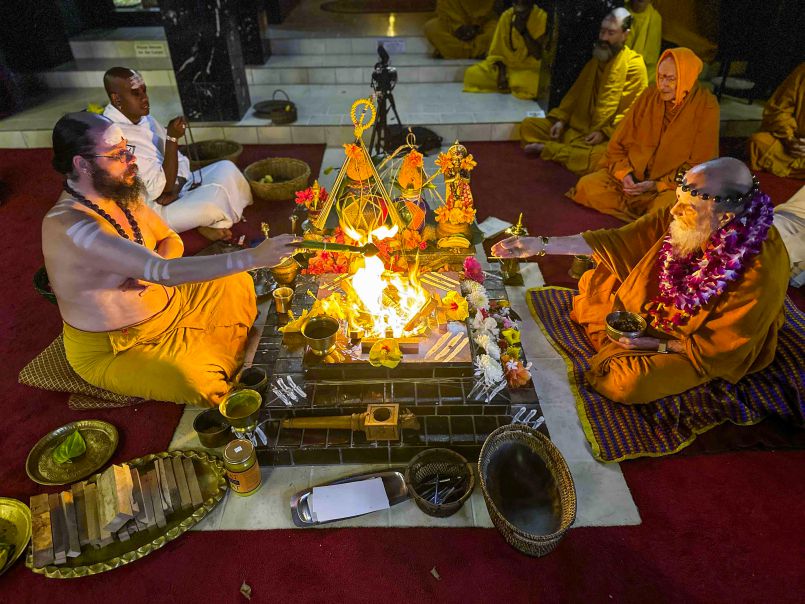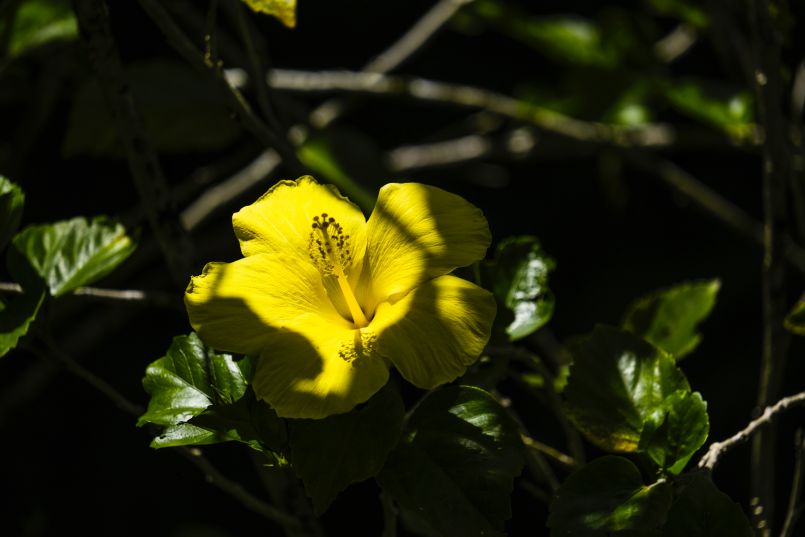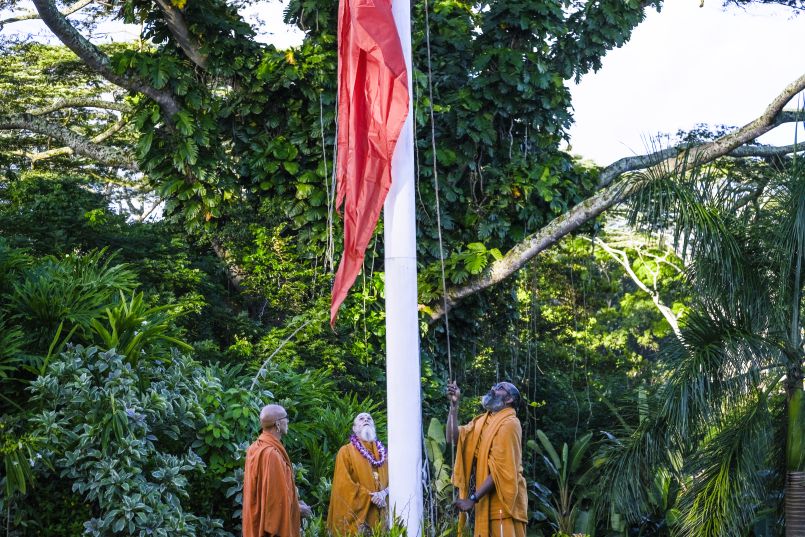Welcome to the 2023 Moksha Ritau!

Aum Namah Sivaya
With the monastery's observance of Sadhu Paksha having come to a close, we enter our next season. Yesterday we began the day with a homa and a parade out to change the flag. Here are reminders from Gurudeva, from his Saiva Dharma Shastras, detailing the significance and sadhanas of this inner season.
112 Introduction
Beginning with Hindu New Year in mid-April, three seasons of the year divide our activities into three great needs of humankind--the learning of scripture in the first season, Nartana Ritau; the living of culture in the second season, Jivana Ritau; and the meditating on Siva in the third season, Moksha Ritau. Thus we are constantly reminded that our life is Siva's life and our path to Him is through study, sadhana and realization. In ritau one, we teach the philosophy; in ritau two, we teach the culture; and in ritau three, we teach meditation.
120 The Third Season: Moksha Ritau
The third period of the year, Moksha Ritau, the cool season, is from mid-December to mid-April. It is the season of dissolution. The key word is resolution. Merging with Siva: Hinduism's Contemporary Metaphysics is the focus of study and intense investigation. The colors of this season are coral-pink, silver and all shades of blue and purple--coral for the Self within, silver and blue for illumination, and purple for enlightened wisdom. High above flies the coral flag, signaling Parasiva, Absolute Reality, beyond time, form and space. Moksha Ritau is a time of appreciation, of gratitude for all that life has given, and a time of honoring elders, those in the sannyasa stage of life. Moksha Ritau is excellent for philosophical discussions, voicing one's understanding of the path through an enlightened intellect. In finance, it is the time for yearly accounting and reconciliation. On a mundane level it is a time of clearing attics, basements, garages, sheds, warehouses, workshops and desks, getting rid of unneeded things, of pruning trees, of streamlining life on the physical plane--of reengineering.
New Maintenance Building Blessing
After many months of construction and recently passing occupancy inspection by county departments, the Siddhidata Kulam can now officially move into the maintenance and storage sections of the new building. They hired our Iraivan Temple priest, Pravin Kumar Gurukal, to perform a "house blessing" puja on his day off.
Enjoy this slideshow of images from the event. Satguru made a point to attend despite having only returned from the Bangkok World Hindu Congress a couple hours earlier.
Skanda Sashti and Supplicant Pledge
We share here a few photos of the Skanda Sashti puja a few days ago (which was also livestreamed), and in the middle of the puja, while Karttikeya was decorated, Brahmachari Shankara Veylan took the six-month Supplicancy Pledge. Having already taken the vow of purity, he now takes on two more vows, the vow of Humility and the vow of Confidence. This pledge declares his intention towards a life of monasticism, as he now begins the final process, by which he will ready himself for the life of the Postulant. From the Sacred Pledge booklet:
"The supplicant's foremost objective is to strive for mastery of the charya marga, or path of service. This begins with the avoidance of wrongful actions and the overcoming of base instincts and emotions as he learns to transmute worldliness into the higher states of devotion and selflessness. At this stage on the path, the Saivite devotee is content not to strive for profound spiritual attainments but to work diligently with the faults and flaws that are stumbling blocks on the path, learning at the same time to depend not only on his own resources but on the limitless abilities of the Gods to resolve all difficulties and dissolve all obstacles. The Supplicancy is a time of profound worship of Lord Ganesha, Lord Murugan and Lord Siva and of deepening commitment and service to Saivite Hinduism and to the Church. It is also a time of study, challenge and inner change. The supplicant is encouraged to strive for the perfection of service and for the monastic ideals of humility, industry and responsibility, renouncing personal needs for the benefit of others. In this service, he should strive for transparency, that quality of anonymous virtue in which the premonastic lives in full harmony with others, remaining centered within and not standing out or disturbing the surroundings. It is this ancient tradition of unseen service and unperturbable stability that the supplicant seeks to emulate, realizing that serving in unheralded ways and renouncing the fruits of even good deeds averts the pitfalls of the spiritual ego and nurtures the state of unpretentiousness. By putting great energy into premonastic life and by serving tirelessly for the benefit not of himself but of others, the supplicant opens himself to the inflow of Lord Siva's grace."Aum Namah Sivaya.
Siddhidata Kulam New Maintenance Shop Updates
Following are some of the specific progress steps taken over the last weeks.
During their final days here, the silpis crafted a beautiful granite sign for the new maintenance shop, storage and office building, called Hale Hana.
The concrete "apron" around the building cured and is ready to use
Mobile tool storage units with work counters were assembled.
A simple bathroom indoors was completed
The storage rooms are all painted and lit, with trip along the base of walls.
Trim was installed around all the doors, and some windows placed.
San Marga Path Deity Moving
Today we moved the Ganesha and Muruga murtis that were just before the svayambhulingam square, to new locations. The Ganesha moved to the other side of our property to giving blessings outside our new maintenance building, while Muruga moved up to the side of Muruga Hill.
We started in the early morning by transferring the Deity shakti into kumbhas, which then sat in a small yagasala with smaller kalashas in front of the svayambhulingam to receive a full homa. While the homa continued, the murtis were moved to their new locations. Then the large kumbhas and small kalashas were paraded to the new locations and poured over the murtis to re-energize them.
We might post additional photos of these events on another day.
Electrifying the New Machine Shop Building and Office
Five electricians from California have begun the process of installing wiring, fans and power outlets throughout the new Siddhidata Kulam metal building, courtesy of our SSC sishya Easvan Param, a longtime electrican.
Three scissor lifts are rented for the project, which will last around a couple weeks.
Through the Lens of Shankara

Aum Namah Sivaya
Today we present a series of artistic imagery taken by our very own Brahmachari Shankara. With camera in hand, he marched out upon our majestic garden lands and took a cornucopia of photos detailing our many plants and waterways. Here are a select few of his images, displaying the many small wonders that stood out to his eye.
Outside the New Siddhidata Kulam Building
Beginning the 2023 Jivana Ritau

The Sawdust Chronicles
Namaskaram Everyone!
Recently, we have upgraded the monitor and sound system that Satguru uses for his presentations in the Guru Pitam. Upon unboxing the new equipment we realized the existing stand was slightly too small to house the new monitor. Fortunately, Mayuresh is here for several weeks on taskforce, working in the woodshop. He has been working on the screen's stand by adding a larger top as well as a small drawer to hold the microphone and sound equipment. He was happy to work on this project because it serves as a opportunity to improve his carpentry skills. Mayuresh remarks "The monastery wood shop has every tool you could ever need for a project!"
From Our Gurus' Teachings
Archives are now available through 2001. Light colored days have no posts. 1998-2001 coming later.
